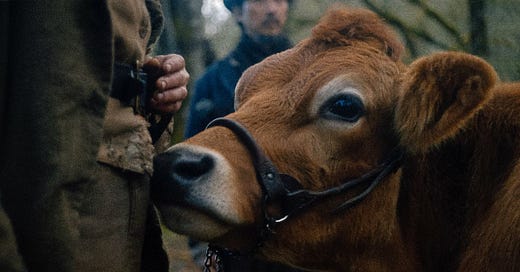Knowing where today sits—after Earth Day and two days before Mother’s Day—we thought we’d suggest a few cultural artifacts that honour the mother of us all.
LISTEN
Joni Mitchell, Canada’s mother of music, writes a lot about Nature and its multitudes. Take a scroll through her catalogue, and you’ll find environmental themes popping up in three key forms: metaphors for conflict between the sexes, identification with birds, and direct environmental outrage. Here are a few examples.
Tension between sexes = Cactus Tree
“And the branches sang the chorus
As he climbed the scaley towers
Of a forest tree
While she was somewhere being free.”
This song does something more songs need to do—it turns the male-centric focus of sex and love on its head and hands the keys to the woman in the story. When I listen to it as a man, I see myself in the male characters. But then every verse ends with his object of affection out “busy being free,” forcing me to take stock of myself and how I interact with the women in my life. Its affect is like a good sermon.
Other examples: The Hissing of the Summer Lawns, Coyote, The Wolf that Lives in Lindsey
Singing to the birds = Black Crow
“Now he's diving down
To pick up on something shiny
I feel like that black crow
Flying
In a blue sky.”
The tension between freedom and slavery in this song hits heavy. You don’t read the lyrics of “Black Crow” and walk away without looking at your own relationship to Desire. Stay clear if you’d prefer to keep diving down for shiny things.
Other examples: Song to a Seagull, Sweet Bird, A Bird that Whistles, The Beat of Black Wings
Green rage = Big Yellow Taxi
“Hey farmer farmer
Put away that DDT now
Give me spots on my apples
But leave me the birds and the bees
Please!”
I mean, come on. You can’t know Joni Mitchell’s name without knowing this song. It’s interesting though: the musical tone of “Big Yellow Taxi” seems so light and funny that it takes a closer look to recognize how serious it is. It’s why I picked the lyric above instead of my favourite:
“They took all the trees
Put 'em in a tree museum,
And they charged the people
A dollar and a half just to see 'em.”
The last verse actually takes an unexpected turn back to the theme of Joni’s relationship with men. It seems out of place at first, but the longer you sit with it, the more it somehow, mysteriously makes sense.
Other examples: Ethiopia, Lakota, Cool Water
-AK
WATCH
Thank Mother God the concept of nature has escaped the reach of history’s largely patriarchal categorization of the world, because the term “Father Earth” would truly be a travesty. The natural world is in a constant state of mothering, as it nurtures and births new extensions of itself all the time. Here are four particularly motherly portrayals of the earth in recent cinema:
Leave No Trace (2018)
Dir. Debra Granik
A motherless girl is nurtured nonetheless by the woods in which she lives and by her father who is her home. No one’s a perfect parent though.
Frozen II (2019)
Dir. Chris Buck, Jennifer Lee
In the wind and the water and an enchanted forest, Elsa unearths memories of her deceased mother and a connection to Mother Earth herself that goes beyond her famous ice-making powers. Break down the dam and let nature’s current flow free!
Moana (2016)
Dir. Ron Clements, John Musker
With the help of her enigmatic grandmother (“Is there something you want to tell me?” “Is there something you want to hear?”), a girl discovers a mystical and long-forgotten connection between the sea and her people, and she sets out on an adventure to find and return the heart to her beloved “mother island.”
First Cow (2019)
Dir. Kelly Reichardt
An earthy, quiet tale of two outsiders living in the rough conditions of 19th century Oregon who are sustained by their friendship, their connection to the land, and a mother’s milk.
-JB
READ
Are You My Mother? by P.D. Eastman
A book I read as a kid that was renewed again in my memory upon reading it to my own child many years later. When her baby is on the verge of hatching, a mother bird leaves the nest in search of food for it. The baby bird hatches when she is away and upon instinctually noticing her absence, he promptly decides to leave the nest to find her.
It’s a surprisingly long and fruitless journey. The bird approaches no less than eight different beings with the titular question (to one broken car he just considers it in his head), and to no avail. I remember being kind of spooked out by the whole thing, and as an adult I can see why. The landscape is desolate and brown and some of the creatures are creepy—the kitten with its big, unblinking yellow eyes, the plane issuing smoke and flying terrifyingly close overhead.
The nature vs. machine dynamic is an interesting one to examine, as a car, a boat, a plane, and a digger follow the four animals that the baby bird sees at the beginning of his journey. The animals have faces and interact with the bird. The machines are stoic and relentless in their industrial duty. The first animal (the kitten) and the last machine (the digger) are exceptions to these rules. The kitten says nothing and only stares at the bird; the digger, however, gives a big “Snort!” and ends up being the baby bird’s saviour, picking him up and returning him to his home where his mother would soon return.
Perhaps our relationship to Mother Earth from under whom we were hatched will follow a similar path to reconciliation: only when we truly return to the natural home she has provided us with and learn to trust in her provision will her nourishing presence be felt by all in need.
-JB
That’s it for now—thanks for reading. Tune in two weeks from now for edition #6, when we’ll think about the number 3.






Thanks for the appropriately seasonal post. It reminded me of the genius of Joni Mitchell--a
generation ahead of her time! I still don't know why "Big Yellow Taxi" is the title of the song. If it was "Paved Paradise" we might not miss the environmental rant so easily.